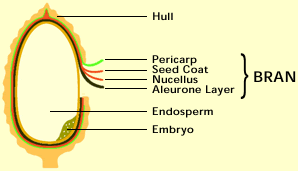
is for food use has been commercially produced in the United States by RITO since 1994. Despite its similarities to other common vegetable oils, rice bran oil offers several unique properties that make it very interesting as a specialty oil in niche markets. It has a very appealing nut-like flavor and once extracted is very stable with good fry-life. But perhaps its most notable feature is its high level of components with nutraceutical value such as gamma-oryzanol and tocotrienols.
The structure of the rice kernel is illustrated in Fig.1. The bran fraction, which includes the germ or embryo in most commercial milling operations, represents only about 8% of paddy weight but contains about three-fourths of the total oil (Juliano and Bechtel, 1985; Lu and Luh, 1991). Containing about 15-20% oil (the same general range of soybeans), rice bran is commercially feasible for oil extraction.
First the husk of the rice grain is removed, resulting in a brown rice grain. The brown bran layer and rice germ are then removed leaving behind a white rice grain.
Rice Bran Oil is first extracted from the bran and germ. The oil is then refined and separated into a clear liquid and hard fraction. The clear liquid is extra cold filtered for maximum purity. The hard fraction is filtered and is used to make Alfa One Rice Bran Oil spread.
Rice bran
Rice bran is a byproduct of the rice milling process (the conversion of brown rice to white rice), and it contains various antioxidants that impart beneficial effects on human health.
A major rice bran fraction contains 12%-13% oil and highly unsaponifiablecomponents (4.3%).
This fraction contains tocotrienols (a form of vitamin E), gamma-oryzanol and beta-sitosterol; all these constituents may contribute to the lowering of the plasma levels of the various parameters of the lipid profile. Rice bran also contains a high level of dietary fibres (beta-glucan, pectin and gum). In addition, it also contains ferulic acid, which is also a component of the structure of nonlignified cell walls. However, some research suggests there are levels of inorganic arsenic (a toxin and carcinogen) present in rice bran. One study found the levels to be 20% higher than in drinking water.
Other types of bran (derived from wheat, oat or barley) contain less arsenic than rice bran, and are just as nutrient-rich.

Kwadwo ampadu-kyere
2019-12-19 - 03 : 29 : 40Need rice bran oil production line machine